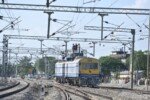HT Bureau
GUWAHATI, April 8: Northeast Frontier Railway (NFR) has made notable strides in strengthening railway safety and upgrading infrastructure across Assam, Bihar and West Bengal. Between April 2024 and March 2025, NFR eliminated 28 manned level crossings (MLCs) through a combination of Road Over Bridges (ROBs), Road Under Bridges (RUBs), Low Height Subways (LHS), direct closures and planned diversions. These efforts have significantly enhanced safety, reduced delays and improved overall operational efficiency. Additionally, the construction of 11 ROBs and 26 RUBs during this period has improved connectivity and ensured smoother, congestion-free movement for both road and rail traffic demonstrating NFR’s ongoing commitment to modern and reliable transportation solutions.
These infrastructure upgrades were carried out by various agencies such as the National Highways Authority of India (NHAI), Railway Divisions, Construction Wings and Deposit Agencies in coordination with State Governments and other stakeholders. The collaborative approach ensured timely completion of projects including significant ROBs at major locations like Dibrugarh, Kamrup Metro, Jorhat and Lakhimpur and RUBs or LHS structures in areas like Alipurduar and Kokrajhar.
Each project was planned based on thorough assessments of traffic volume and local requirements. For example, high-traffic sites such as FM-57 in Jorhat and RM-257 in Lakhimpur were equipped with well-structured Road Over Bridges (ROBs) to ensure enhanced safety and continuous connectivity. In contrast, locations with lower traffic were managed through direct closures to make efficient use of resources.
These developments have already begun to transform the transportation landscape in Northeast India. Notable benefits include the elimination of accident-prone level crossings, reduction in road congestion and travel delays, uninterrupted train operations and an overall improvement in logistics and passenger movement. Furthermore, these efforts have positively impacted regional economies, particularly in remote and border districts by improving accessibility and enabling smoother freight movement, a release stated.












